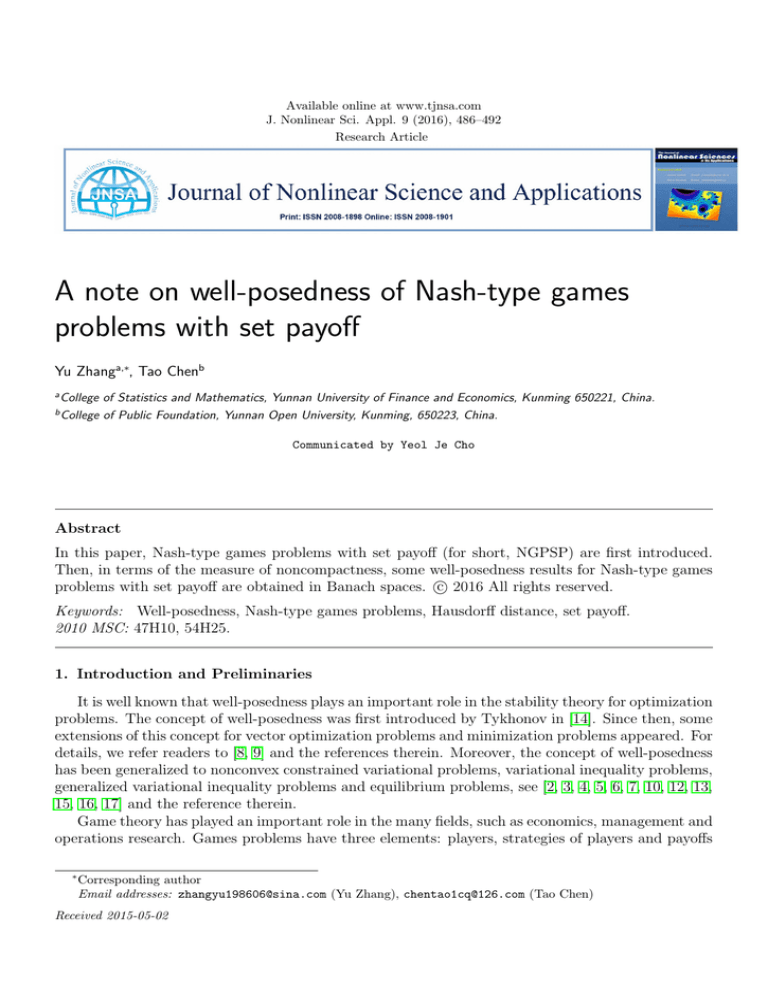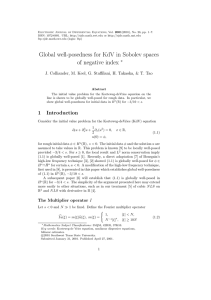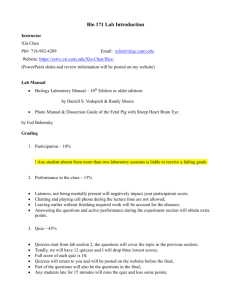
Available online at www.tjnsa.com
J. Nonlinear Sci. Appl. 9 (2016), 486–492
Research Article
A note on well-posedness of Nash-type games
problems with set payoff
Yu Zhanga,∗, Tao Chenb
a
b
College of Statistics and Mathematics, Yunnan University of Finance and Economics, Kunming 650221, China.
College of Public Foundation, Yunnan Open University, Kunming, 650223, China.
Communicated by Yeol Je Cho
Abstract
In this paper, Nash-type games problems with set payoff (for short, NGPSP) are first introduced.
Then, in terms of the measure of noncompactness, some well-posedness results for Nash-type games
c 2016 All rights reserved.
problems with set payoff are obtained in Banach spaces. Keywords: Well-posedness, Nash-type games problems, Hausdorff distance, set payoff.
2010 MSC: 47H10, 54H25.
1. Introduction and Preliminaries
It is well known that well-posedness plays an important role in the stability theory for optimization
problems. The concept of well-posedness was first introduced by Tykhonov in [14]. Since then, some
extensions of this concept for vector optimization problems and minimization problems appeared. For
details, we refer readers to [8, 9] and the references therein. Moreover, the concept of well-posedness
has been generalized to nonconvex constrained variational problems, variational inequality problems,
generalized variational inequality problems and equilibrium problems, see [2, 3, 4, 5, 6, 7, 10, 12, 13,
15, 16, 17] and the reference therein.
Game theory has played an important role in the many fields, such as economics, management and
operations research. Games problems have three elements: players, strategies of players and payoffs
∗
Corresponding author
Email addresses: zhangyu198606@sina.com (Yu Zhang), chentao1cq@126.com (Tao Chen)
Received 2015-05-02
Y. Zhang, T. Chen, J. Nonlinear Sci. Appl. 9 (2016), 486–492
487
functions. However, it is difficult to know the exact values of payoffs owing to some unexpected
situations. We can only give an estimate of values of payoffs. Therefore, games problems with set
payoff become an interesting research topic.
Throughout this paper, let I be a finite index set and for each i ∈ I, let Xi be a real Banach
space, let Yi Q
be a real Banach
closed convex cone Ci , and intCi 6= ∅. For each
Q space with proper
i
i
i ∈ I, X = i∈I Xi , X = j∈I,j6=i Xj , Fi : X × Xi → 2Yi and Si : X i → 2Xi . For each x ∈ X,
suppose that xi and xi denote the ith coordinate of x and the projection of x on X i , respectively. In
this paper, we may write x = (xi , xi ). We introduce the following Nash-type games problems with
set payoff:
the game problem is to find x̄ = (x̄)i∈I ∈ X, ȳi ∈ Fi (x̄i , x̄i ) such that
for each i ∈ I,
x̄i ∈ Si (x̄i ),
and
yi − ȳi 6∈ −intCi ,
for all yi ∈ Fi (x̄i , ui ) and all ui ∈ Si (x̄i ).
Remark 1.1.
(i) If I = {1, 2}, the problem is to find x̄ = (x̄1 , x̄2 )i∈I ∈ X, y¯1 ∈ F1 (x̄2 , x̄1 ), y¯2 ∈ F2 (x̄1 , x̄2 ) such
that for each i ∈ I, x̄i ∈ Si (x̄i ), and
(NGPSP)
yi − ȳi 6∈ −intCi , for all yi ∈ Fi (x̄i , ui ) and all ui ∈ Si (x̄i ),
1
2
where x̄ = x̄2 , x̄ = x̄2 .
(ii) For each i ∈ I, if Fi is a real-valued function, the problem reduces to the Nash-type game
problem with real-valued payoff functions in [13].
Motivated by the earlier work, we introduce the well-posedness for (NGPSP) and some wellposedness results for (NGPSP) are obtained by using the measure of noncompactness.
The rest of the paper is organized as follows. In Section 2, we present the concepts of wellposedness and approximate solution set. In Section 3, we establish some metric characterizations for
well-posedness by using the measure of noncompactness.
In this paper, We assume that the set of solutions for (NGPSP) is always nonempty, denoted by
Q. Let ei ∈ intCi , i ∈ I. Now, we introduce the definitions of approximate solution sequences and
well-posedness for (NGPSP).
Definition 1.2. A sequence {xn = (xni , xin )}i∈I ⊆ X is called an approximate solution sequence for
1
(NGPSP) if there exists {n } ⊆ R+
with n → 0 such that
d(xni , Si (xin )) ≤ n ,
∀n ∈ N,
i ∈ I,
and
∃ȳni ∈ Fi (xin , xni ) such that yni − ȳni +n ei 6∈ −intCi , ∀yni ∈ Fi (xin , uni ) ∀uni ∈ Si (xin ) ∀n ∈ N, i ∈ I.
Definition 1.3. (NGPSP) is said to be well-posed [respectively, well-posed in the generalized sense]
if there exists a unique Nash game x̄ and every approximate solution sequence strongly converge to
x̄[respectively, if Q 6= ∅ and every approximate solution sequence has a subsequence which strongly
converges to some point of Q].
Y. Zhang, T. Chen, J. Nonlinear Sci. Appl. 9 (2016), 486–492
488
Remark 1.4. (NGPSP) is well-posed in the generalized sense implies that the solution set Q is
nonempty and compact.
Definition 1.5 ([1]). Let X and Y be two normed spaces. A set-valued mapping G from X to Y is
called
(i) closed if for every x ∈ X, for every sequence {xn } converging to x, and for every sequence {yn }
converging to a point y, such that yn ∈ G(xn ), ∀n ∈ N , one has y ∈ G(x);
(ii) subcontinuous on X if for every convergent sequence {xn } converging to x, every sequence {yn }
with yn ∈ G(xn ), {yn } has a convergent subsequence;
(iii) upper semicontinuous (u.s.c.) if for every x ∈ X, if for any neighborhood N (G(x)) of G(x),
there exists a neighborhood N (x) of x such that
G(x) ⊂ N (G(x)),
∀x ∈ N (x);
(iv) lower semicontinuous (l.s.c.) if for every x ∈ X, for every sequence {xn } converging to x, and
for every y ∈ G(x), there exists a sequence {yn } converging to y, such that yn ∈ G(xn ) ∀n ∈ N ;
(v) continuous at x0 ∈ X if G is both u.s.c. and l.s.c. at x0 .
2. Main results
In this section, we shall give characterizations for well-posedness of (NGPSP).
First, we present the Kuratowski measure of noncompactness for a nonempty subset B of X ([9])
defined by
n
[
α(B) = inf{ε > 0 : B ⊂
Bi , for every Bi , diamBi < },
i=1
where diam(Bi ) be the diameter of Bi defined by
diam(Bi ) = sup{d(x1 , x2 ) : x1 , x2 ∈ Bi }.
Definition 2.1 ([11]). Let (X, d) be a metric space. Given two nonempty subsets A and B of X,
the Hausdorff distance between A and B is defined as
H(A, B) = max{e(A, B), e(B, A)},
where e(A, B) = sup{d(a, B) : a ∈ A} and d(a, B) = inf b∈B d(a, b).
In order to study the well-posedness for (NEP), we introduce the approximate solution set for
(NGPSP) which is defined by
Q = {x̄ = (x̄i , x̄i ) : d(x̄i , Si (x̄i )) ≤ , ∃ȳi ∈ Fi (x̄i , x̄i ) and yi − ȳi + ei 6∈ −intCi , for all yi ∈
Fi (x̄i , ui ) and all ui ∈ Si (x̄i ), ∀i ∈ I}, where > 0.
For the sake of simplicity, we restrict ourselves to I = {1, 2}. But the result can be easily obtained
for finite players.
Theorem 2.2. If (NGPSP) is well-posed ,then
Q 6= ∅, ∀ > 0
and
Moreover, if the following conditions are satisfied:
lim diamQ = 0.
→0
(2.1)
Y. Zhang, T. Chen, J. Nonlinear Sci. Appl. 9 (2016), 486–492
489
(i) Fi : X i × Xi → 2Yi is continuous with compact values;
(ii) Si : X i → 2Xi is closed, subcontinuous and lower semicontinuous,
then the converse holds.
Proof. If (NGPSP) is well-posed, then the set Q is a singleton. Q is always nonempty for every
, since Q ⊆ Q . By contradiction, assume that limn →0 diamQn > β > 0, for some sequence
{n } ⊆ R1+ . We could find two sequences {(xn )i∈I } and {(zn )i∈I } satisfying xn ∈ Qn , zn ∈ Qn and
k xn − zn k> β, for n large enough. Since {xn }, {zn } are approximate solutions for (NGPSP) and
should converge to the unique solution, we get a contradiction with the assumption.
Now, we assume that (2.1) holds and {xn = (xn1 , xn2 )} ⊆ X is an approximate solution sequence
for (NGPSP). Then there exists a sequence {tn } ⊆ R1+ decreasing to 0, such that
d(xni , Si (xin )) ≤ tn ,
∀n ∈ N,
i = 1, 2
(2.2)
and
∃ȳni ∈ Fi (xin , xni ) s.t. yni − ȳni + tn ei 6∈ −intCi ,
∀yni ∈ Fi (xin , uni ) and ∀uni ∈ Si (xin )∀n ∈ N, i = 1, 2.
(2.3)
According to the assumption, we conclude that {xn } is a Cauchy sequence and has to converge to
some point x̃ = (x̃1 , x̃2 ) ∈ X. Next, we only need to show that x̃ ∈ Q.
From (2.2), we get that d(xn1 , S1 (xn2 )) ≤ tn . Let ηn1 ∈ S1 (xn2 ) such that k ηn1 −xn1 k≤ tn + n1 , for
each n ∈ N . Since S1 is (τ, σ)-closed and (τ, σ)- subcontinuous, the sequence {ηn1 } has a subsequence,
still denoted by {ηn1 }, which converges to a point η1 ∈ S1 (x̃2 ). It follows that
k (xn1 − x̃1 ) − (ηn1 − η1 ) k =k (xn1 − ηn1 ) − (x̃1 − η1 ) k
=k (x̃1 − η1 ) − (xn1 − ηn1 ) k
≥k x̃1 − η1 k − k xn1 − ηn1 k .
We have k x̃1 − η1 k≤k xn1 − ηn1 k + k (xn1 − x̃1 ) − (ηn1 − η1 ) k.
Therefore, k x̃1 − η1 k≤k xn1 − ηn1 k + k ((xn1 − x̃1 ) − (ηn1 − η1 ) k≤ tn + n1 = 0. Thus, x̃1 ∈ S1 (x̃2 ).
Similarly, we can get that x̃2 ∈ S2 (x̃1 ).
For each i ∈ I, in the light of (2.3) and assumption (i), the sequence {ȳni } have subsequences
which converge to ȳi ∈ Fi (x̃i , x̃i ). For all ui ∈ Si (x̃i ), since Si is (τ, σ)-lower semicontinuous, there
exists a sequence {uni } converging to ui such that uni ∈ Si (xin ) ∀n ∈ N . And for all yi ∈ Fi (x̃i , ui ), by
virtue of the continuity and compactness of Fi , there exists yni satisfying yni → yi , yni ∈ Fi (xin , uni )
∀n ∈ N . Moreover, yni − ȳni +tn ei ∈ Yi \(−intCi ), we have that yi − ȳi ∈ Yi \(−intCi ) by the closedness
of Yi \ (−intCi ), for all yi ∈ Fi (x̃i , ui ) and all ui ∈ Si (x̃i ). The uniqueness follows immediately from
(2.1). Thus, we complete the proof.
Now we obtain an characterization for generalized well-posedness for (NGPSP) by using the
Kuratowski measure.
Theorem 2.3. If (NGPSP) is well-posed in the generalized sense, then
Q 6= ∅, ∀ > 0 and
Moreover, assume the following conditions hold:
lim α(Q ) = 0.
→0
(2.4)
Y. Zhang, T. Chen, J. Nonlinear Sci. Appl. 9 (2016), 486–492
490
(i) Fi : X i × Xi → 2Yi is continuous with compact values;
(ii) Si : X i → 2Xi is closed, subcontinuous and lower semicontinuous on X i ,
then the converse holds.
Proof. Let (NGPSP) be well-posed in the generalized sense, then Q is nonempty and compact.
Obviously, Q 6= ∅ for any > 0, since Q ⊆ Q . If {xn }i∈I is a sequence of Nash equilibria, it is also
approximate solution sequence. By virtue of assumption, {xn } contains a subsequence converging
to a Nash equilibrium. In the following, we show that limn α(Qn ) = 0 for every n decreasing to 0.
Observe that
H(Qn , Q) = max{e(Qn , Q), e(Q, Qn )} = e(Qn , Q).
Hence,
α(Qn ) ≤ 2H(Qn , Q) + α(Q) = 2e(Qn , Q) = 2 sup d(x, Q),
x∈Qn
where α(Q) = 0, since Q is compact. To get (2.4), it is sufficient to show that
lim sup d(x, Q) ≤ 0.
n x∈Q
n
Suppose that limn supx∈Qn d(x, Q) > γ > 0. Then, there exits a positive integer k and xn ∈ Qn
satisfying d(xn , Q) > γ for arbitrary n ≥ k. So, the sequence {xn } has no subsequence converging to
a point of Q, which contradicts the assumption.
Conversely, we assume that (2.4) holds. We follow the proof of Theorem 2.2 that Q is closed.
By the Kuratowski theorem, we have
H(Q , Q) → 0 as → 0,
(2.5)
T
where Q = >0 Q is nonempty and compact.
Let {xn } be any approximate solution sequence for (NGPSP). Then there exists n ≥ 0 with
n → 0 such that {xn } ⊆ Qn . Due to (2.5), d(xn , Q) → 0. Then, there exits a sequence {pn }i∈I ∈ Q
such that d(xn , pn ) =k xn − pn k→ 0. As Q is compact, the sequence {pn } has a subsequence {pnk }
converging to p̄ ∈ Q. We could easily obtain that {xn } has a subsequence converging to p̄. Therefore,
(NGPSP) is well-posed in the generalized sense.
If for each i ∈ I, Fi is single-valued function, denoted by fi , Yi = R and Si (X i ) = Xi , the
Nash equilibrium problem is to find x̄ = (x̄)i∈I ∈ X, such that for each i ∈ I, x̄i ∈ Xi and
fi (x̄i , x̄i ) ≤ fi (x̄i , zi ), for all zi ∈ Xi .
Remark 2.4. In [13], the following Nash games problems with real-valued payoff is studied. A point
x̄ = (x̄1 , x̄2 ) ∈ X1 × X2 is a Nash equilibrium if: f1 (x̄1 , x̄2 ) ≤ f1 (z1 , x̄2 ), ∀z1 ∈ X1 ; and f2 (x̄1 , x̄2 ) ≤
f1 (x̄1 , z2 ), ∀z2 ∈ X2 , where fi : X1 × X2 → R ∪ {+∞}.
For the above Nash-type games problems with real-valued payoff, we introduce the following
similar definitions of approximate solutions sequence and approximate solution set. Let Q̂ denotes
the solution set of the above problem.
Definition 2.5. A sequence {xn }i∈I ⊆ X is called an approximate solution sequence for (NGPSP)
1
if there exists {n } ⊆ R+
with n → 0 such that
d(xni , Si (xin )) ≤ n , ∀n ∈ N, i ∈ I,
Y. Zhang, T. Chen, J. Nonlinear Sci. Appl. 9 (2016), 486–492
491
and
fi (xin , xni ) ≤ fi (xin , zi ) + n
for all zi ∈ Xi , ∀n ∈ N, i ∈ I,
the approximate solution set
Q̂ = {x̄ = (x̄i , x̄i ) : d(x̄i , Si (x̄i )) ≤ , fi (x̄i , x̄i ) ≤ fi (x̄i , zi ) + , for all zi ∈ Xi , ∀i ∈ I}.
By using the above definitions, we obtain the following well-posed results for Nash-type games
problems with real-valued payoff.
Theorem 2.6. If Xi (i ∈ I) is compact and the following conditions are satisfied:
(i) fi : X i × Xi → R is lower semicontinuous on X;
(ii) For every zi ∈ Xi , the function fi (., zi ) is upper semicontinuous on Xi (i ∈ I);
(iii) Si : X i → 2Xi is (τ, σ)-closed and (τ, σ)-subcontinuous,
then (NGPSP) is well-posed in the generalized sense.
Proof. Let {xn = (xn1 , xn2 )} ⊆ X be an approximate solution sequence for (NGPSP). Then, there
1
with n → 0 such that
exists {n } ⊆ R+
d(xni , Si (xin )) ≤ n ,
∀n ∈ N,
i ∈ I,
and
fi (xin , xni ) ≤ fi (xin , zi ) + n
for all zi ∈ Xi ,
∀n ∈ N,
i ∈ I.
(2.6)
By virtue of the compactness of Xi , {xn } has a subsequence converging to x̌ = (x̌1 , x̌2 ). We only
need to prove that x̌ ∈ Q̂. Using the proof similar to that of Theorem 2.2 , we get that x̌i ∈ Si (x̌i ).
By the assumption (i), (ii) and (2.6), we get that
f1 (x̌2 , x̌1 ) ≤ lim inf f1 (xn2 , xn1 ) ≤ lim inf (f1 (xn2 , z1 ) + n )
n
n
≤ lim sup(f1 (xn2 , z1 ) + n ) ≤ f1 (x̌2 , z1 ), ∀z1 ∈ X1 .
n
By the same way, f2 (x̌1 , x̌2 ) ≤ f2 (x̌1 , z2 ), ∀z1 ∈ X2 . So, we complete the proof.
Remark 2.7. In [13], under some closedness, convexity and lower semicontinuous of real-valued payoff
functions assumptions, some well-posed results with parameter α are also obtained for the above
Nash-type games problems with real-valued payoff. However, the above theorem doesn’t need the
convexity assumptions of real-valued payoff functions. Hence, our results are different from ones in
the literatures.
Acknowledgements:
This research was partially supported by the Natural Science Foundation of Yunnan Province
(No. 2014FD023), Education Department Science Research Foundation of Yunnan Province(No.
2014Y369) and Scientific Research Foundation for Advanced Talents of Yunnan University of Finance
and Economics(No. YC2015D10).
Y. Zhang, T. Chen, J. Nonlinear Sci. Appl. 9 (2016), 486–492
492
References
[1] J. P. Aubin, I. Ekeland, Applied Nonlinear Analysis, Dover Publications, Inc., New York, (2006). 1.5
[2] J. W. Chen, Y. J. Cho, X. Q. Ou, Levitin-polyakwell-posedness for set-valued optimization problems
with constraints, Filomat, 28 (2014), 1345–1352. 1
[3] J. W. Chen, Y. J. Cho, Z. P. Wang, The existence of solutions and well-posedness for bilevel mixed
equilibrium problems in Banach spaces, Taiwan. J. Math., 17 (2013), 725–748. 1
[4] J. W. Chen, Y. C. Liou, Systems of parametric strong quasi-equilibrium problems:existence and wellposedness aspects, Taiwan. J. Math., 18 (2014), 337–355. 1
[5] J. W. Chen, Z. P. Wang, Y. J. Cho, Levitin-Polyak well-posedness by perturbations for systems of
set-valued vector quasi-equilibrium problems, Math. Methods Oper. Res., 77 (2013), 33–64. 1
[6] J. W. Chen, Z. P. Wang, L. Y. Yuan, Existence of solutions and α-well-posedness for a system of
constrained set-valued variational inequalities, Numer. Algebra Control Optim., 3 (2013), 567–581. 1
[7] N. J. Huang, X. J. Long, C. W. Zhao, Well-posedness for vector quasi-equilibrium problems with application, J. Ind. Manag. Optim., 5 (2009), 341–349. 1
[8] X. X. Huang, X. Q. Yang, Generalized Levitin-Polyak well-posedness in constrained optimization, SIAM
J. Optim., 17 (2006), 243–258. 1
[9] K. Kuratowski, Topology, Editions Jacques Gabay, Sceaux, (1992). 1, 2
[10] S. J. Li, M. H. Li, Levitin-Polyak well-posedness of vector equilibrium problems, Math. Methods Oper.
Res., 69 (2009), 125–140. 1
[11] S. J. Li, K. L. Teo, X. Q. Yang, Generalized vector quasi-equilibrium problems, Math. Methods Oper.
Res. 61 (2005), 385–397. 2.1
[12] S. J. Li, W. Y. Zhang, Hadamard well-posed vector optimization problems, J. Global Optim., 46 (2010),
383–393. 1
[13] M. B. Lignola, J. Morgan, α-Well-posedness for Nash equilibria and for optimization problems with
Nash equilibrium constraints, J. Global Optim., 36 (2006), 439–459. 1, ii, 2.4, 2.7
[14] A. N. Tykhonov, On the stability of the functional optimization problem, Filomat, 6 (1966), 28–33. 1
[15] W. Y. Zhang, Well-posedness for convex symmetric vector quasi-equilibrium problems, J. Math. Anal.
Appl., 387 (2012), 909–915. 1
[16] W. Y. Zhang, S. J. Li, K. L. Teo, Well-posedness for Set Optimization Problems, Nonlinear Anal., 71
(2009), 3769–3778. 1
[17] J. Zeng, S. J. Li, W. Y. Zhang, X. W. Xue, Hadamard well-posedness for a set-valued optimization
problem, Optim. Lett., 7 (2013), 559–573. 1





